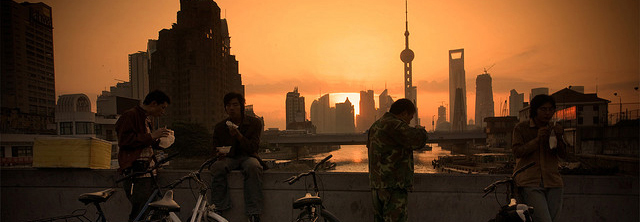The shadows of Shanghainese decadence and excess
Re-establishing the Paris of the East at any cost?
Source: http://www.poverties.org/images/shanghai-migrant-workers-poverty-line.jpg
Returning from Shanghai after 10 days, if I were to describe the city with only one word, it would most likely be “excess”. It does not take long to get overwhelmed by the economic wealth and abundance in this city. In the various nightclubs of the city’s skyline, Shanghainese bourgeois lifestyle becomes shockingly apparent; where Ferraris and Lamborghinis are lined up in the parking lots and where parties of two to three young Shanghainese are casually served eight bottles of Moët & Chandon at their table. It becomes clear that whoever is seriously in the money in Shanghai, has to show publicly what they have got.
Only a few streets away from the hustle of the glitz world, the sobriety of life of the other people in Shanghai is stifling. Due to the language and cultural barrier, it is difficult to gain access to this other side of Shanghai in the short time being. Therefore, the lives of its inhabitants only unclose to us in brief, bizarre street scenes. People in pajama like outfits are sitting on miniature plastic stools at street corners eating street food from hawkers in the middle of the night. Who they are and where they come from at this hour is left to our imagination, but we can only assume that these are the people that Shanghai really owes his revival of the last 25 years to. The army of cheap laborers that is refurbishing and constructing the city to support the Central Government’s plan of 1990 to make Shanghai the non-colonial poster child of modern development and bring it back to its old glory of the 1930s, when it was considered the “Paris of the East”.
Back then Shanghai was booming with international capital, the Bund was the Wall Street of Asia, the city had a thriving cultural scene and was notorious for a lavish lifestyle. Shanghai’s raison d’être trade is accounted for by its excellent geographical location, which quickly turned Shanghai from a small cotton and textile center at the beginnings of the opium trade in the mid 19th century into the flourishing city it became after. In 1934 at its economic zenith and shortly before its downfall, Shanghai had more cars than the rest of China combined and accounted for a major part of China’s international trade.
However, the almost a century of Shanghai’s heyday was marked by oppression, inequality and Western supremacy over the local Chinese population. Roughly 80 years later, the faces that dominate the revived metropolis and that are spending the big money, might have become predominantly Chinese, but the story of exploitation still seems to be the same as during Shanghai’s first phase of glory. Overshadowed by the modernity and pomp of the city, is a huge underclass of poor Chinese migrant workers from the countryside – Shanghai’s “floating population”. Estimations state that migrant workers could account for up to 40% of Shanghai’s population, with the whole population by itself already being half as big as the population of Spain. Migrant workers are subject to the discrimination of the Hukou system, the Chinese system for household registration, which limits legal residence to the place of family origin. This system led to strong social disadvantages for the rural population, which could not partake in the economic upswing of the urban areas. Today the Hukou system forces rural migrant workers into the lowest paid jobs in the big cities such as Shanghai while being excluded from the privileges of the cities’ official inhabitants such as the free access to educational establishments.
This growing class of unofficial citizens poses a major threat to the development and the stability of Shanghai and China as a whole. On a path to a more sustainable future, China is already starting to address environmental concerns. Now, it is left to hope that China realizes and acts rigorously towards the instability that sneaks up from the wealth and inequality of its multi-million cities.





.png)
].gif)
.png)
].png)
].png)
].png)
.png)
].png)
.png)
